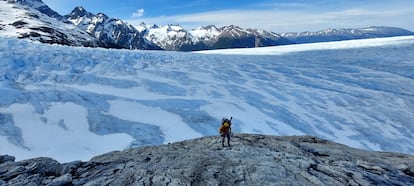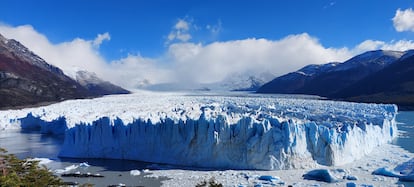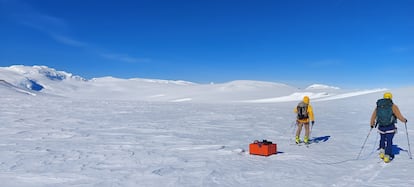Argentina’s ice giant shows signs of setbacks
Scientists are warning of a significant loss of mass in Argentina’s most famous glacier, Perito Moreno. This is possibly related to climate change

An icy breeze grips your hands and face. The Perito Moreno Glacier — 100 square miles of white surface — stands out before the eyes of thousands of tourists, who view it from the walkways in the Los Glaciares National Park. This region is part of the Southern Andes of Argentina, close to the border with Chile.
This enormous mass of white and crystalline blue ice — with walls that are almost 200 feet high – has been retreating on its northern front. The scientific community has been studying this decline with special attention.
According to satellite monitoring and measurements taken with ground-penetrating radar, scientists warn that “unlike other glaciers, Perito Moreno didn’t change for a long time. If the balance of its mass is calculated over the last 50 years, the average [change was] zero. It was a giant that gained or lost very little mass,” explains Lucas Ruiz, a scientist at the Argentine Institute of Glaciology and Environmental Sciences (IANIGLA). He’s also a researcher at the National Council for Scientific and Technical Research (CONICET). Together with his team, Ruiz studies the behavior of the glacier through a methodology that calibrates a numerical model, observing the long-term changes in the glacier’s mass. The measurements are made using the amount of accumulated snow, which is compared to the amount of ice lost.
Perito Moreno is one of the 49 glaciers that form the Southern Patagonia Ice Field, which is the largest area of ice that exists in the entire southern hemisphere, excluding Antarctica. This large area occupies 4,773 square miles and is located between Argentina and Chile. Glaciers are reservoirs of freshwater that are formed by snow that doesn’t melt.

From the north to the south of Argentina — along 2,200 miles of the Andes in 12 of the country’s 23 provinces — there are more than 16,000 glaciers and 39 water basins. “Having glaciers mainly in the mountain range is like driving in the car with a seat belt. If something happens — if there are droughts — the glacial ‘belt’ is the reserve of solid water,” Ruiz explains. In this way, glaciers benefit the planet during the driest times of the year, by losing mass and providing water. And, if there’s a surplus of snow, that treasure of frozen water is recovered again.
Melting glaciers and global warming
Since 2020, researchers from IANIGLA have observed a retreat in Perito Moreno. They interpret this as a loss of mass consisting of more than 2,300 feet… approximately seven blocks. “We have to be very cautious. We’ll have to continue observing to be certain that the glacier is indeed beginning a phase of retreat, because it still hasn’t lost its foothold within the peninsula,” Ruiz clarifies.
There are questions about whether this retreat is related to global warming. The increase in temperature is key to analyzing thaw contexts. Pedro Skvarca — the scientific director of Glaciarium, a glaciological study center in Argentine Patagonia — assures EL PAÍS that 2022 was one of the warmest years in South America since records began to be kept in 1910. “A factor is added to the temperature, which is an underwater moraine, a kind of mountain of rocks on which the glacier was resting — it has broken away [from the glacier],” he explains, during a press conference at Glaciarium.
This phenomenon of mass ice loss has also been observed in other glaciers across the region of Argentine Patagonia, such as the famous Upsala Glacier, close to Perito Moreno. Together, they share Argentino Lake. Three years ago, a process of movement and mass loss began. In just eight months, it retreated by 1,000 feet in its eastern section.
All of this is related: the underwater moraine that broke away from the Perito Moreno Glacier, the loss of mass linked to the increase in summer temperatures, the pressure of subglacial water that influences the base…. everything points to a change that must be observed very carefully. “I already saw the disintegration of the Larsen Ice [Shelf] in Antarctica. The world is misusing energy and very few people are aware that something needs to be done. Nature alone cannot combat this damage,” Skvarca warns.

Ruiz from IANIGLA points to the role of greenhouse gas emissions and carbon dioxide concentration in climate change. “It’s mainly due to the burning of fossil fuels that the concentration of these gases in the atmosphere is the highest [ever] in the last two million years, which generates an abnormal warming that we call climate change.” This explanation coincides with a study carried out by the Environment and Natural Resources Foundation, which looked at the case of Argentina’s oil fields. It mentions the general environmental impacts, which are released into the atmosphere.
Through the Paris Agreement and through the National Plan for Adaptation and Mitigation of Climate Change, Argentina has made commitments to limit global warming, planning for a net reduction of carbon emissions by 2050. However, the president-elect — Javier Milei — denies the existence of climate change. During his campaign, he promised to leave the Paris Agreement, which seeks to limit the increase in global temperatures to 1.5 ºC before 2050. He has also vowed to gut the financing of scientific research. He takes office on December 10.
Scientists, the guardians of glaciers
In the face of political uncertainty, scientists warn that more studies are needed. They also emphasize that the basic science required to obtain data in remote places — such as glaciers — isn’t cheap. “Taking measurements in the accumulation zone of the large glaciers that make up the Southern [Patagonia] Ice Field means assembling teams of several people [and] [contracting] helicopters to assist us. There are also other risks that come with an expedition in a remote area,” Ruiz cautions.
Therefore, multinational collaborations have become essential. Recently, an expedition made up of scientists from Germany, Chile and Argentina carried out studies using a German plane to better understand the changes in the glaciers of the large ice fields of Patagonia.
There’s no doubt that Perito Moreno’s greatest allies and guardians are the scientists. Those interviewed by EL PAÍS insist on the urgency of caring for the glaciers, while continuing to study them. “Glaciers are a kind of freshwater savings bank that is becoming smaller and smaller. It’s essential to discuss how we’re going to mitigate the effect of global warming,” Ruiz concludes.
Sign up for our weekly newsletter to get more English-language news coverage from EL PAÍS USA Edition








































